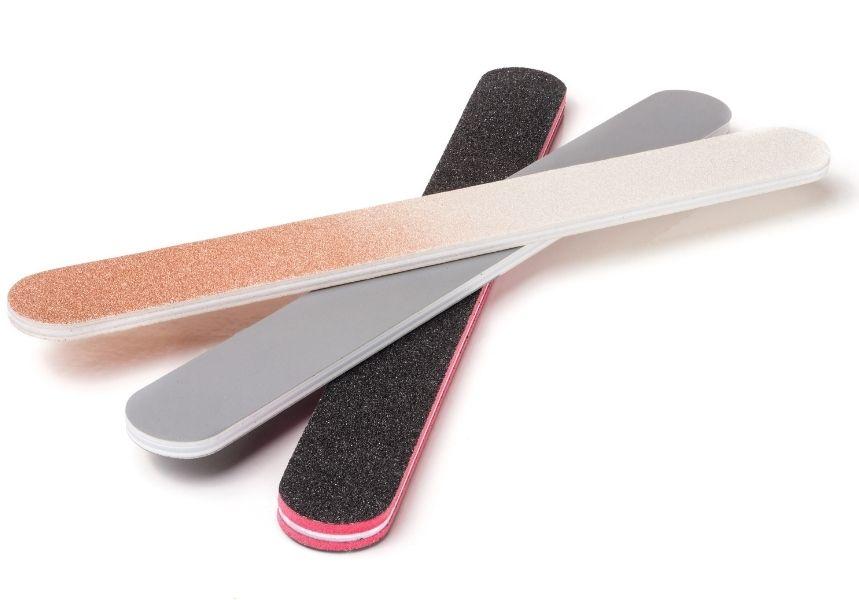Straight, bent like a banana, made from crystal, endless grit grades – who knew buying a nail file could be this complicated?!
Whether you’re searching for a DIY quick fix at home or for your beauty salon, every great manicure starts with a file – but not all nail files are created equal. So where do you start?
Here at Semilac Shop UK, we love all things nails, and to help you keep your talons in ship shape, we’ve taken a closer look at this essential tool to bring you the nitty-gritty on nail files…
The shape
When we mentioned a banana, we weren’t joking! One of the most popular nail file shapes out there resembles the shape of this fruit bowl staple and a quick search of the market reveals plenty more unusual forms. There are boats, blocks, S-shaped and – thank goodness – yes, just regular straight files too. But what’s the difference?
Let’s review some of the most popular:
- The straight file - great for everyday use, it can be used to model nails into just about any shape. But don’t be fooled by its simplistic appearance - invariably these go-to files are double-sided, offering different grains to add to their multifunctionality.
- The boat – this specially profiled file cleverly incorporates a curved and straight edge to work with, making it a great all-purpose file that performs well with both gel polish and acrylic nails.
- The banana – the gentle curve of this file allows you to easily shape your nails. Comfortable to hold and use, it simplifies filing by helping you to get to the tricky areas at the side of the nail without causing damage to the skin.
- The block – with four sides to go at there’s plenty of filing to be done with the block. Often with made with fine-grained surfaces for buffing the surface of nails.
Essentially though, especially when you’re buying quality boards like those found in the Semilac range, the differences are negligible. Whilst each has their own strengths and advantages the most important thing – especially for a home manicure – is that it’s comfortable to hold and feels easy for you to use and manoeuvre

Grit grades
Perhaps more crucial than the shape of your file, is its grit grade. But what is this?
If you take a closer look at most nail files you will usually find a set of numbers hidden somewhere – these are the ‘grit grade’. Essentially, they refer to the coarseness of the nail file with lower numbers meaning fewer grains and so a coarser file.
The numbers stretch from 80 to 400 with 80 recommended for the toughest jobs – removing hard acrylic surfaces and 100 recommended for shortening and shaping. And remember, nails wearing gel polish are easier to file than acrylic nails so go steady and ease up on the pressure.
The best allrounder? 180 – a relatively fine grit, great for touch ups on long nails and for working on the natural nail bed.
The higher grit grades are more delicate and so are typically used for buffing and polishing.
The material
Historically nails files were often made from metal but this is mostly avoided these days as it’s considered too harsh and can easily damage the nail if you’re not careful.
Paper files are usually cheap and pretty durable, but glass and crystal boards are a gentler option that can help to avoid chipping and peeling.
Here at Semilac Shop, we stock the very latest range of Semilac nail files, which are made from innovative Japanese plastic and are design to give you a fantastic finish, file after file.
How often should I replace my nail file?
Files can be disinfected and used multiple times. To stay on top of your file hygiene and maximise its life span, simply brush off any nail dust after use and wash with a touch of soap before spraying with a disinfectant.
Looking after your nail file is the key to its longevity but remember - no nail file is meant to last forever and eventually you will have to purchase a new one. Keep an eye out for filing taking longer, this is usually a good indication you’re ready for a replacement.

Check your technique
Whilst finding the right file is important, technique plays a big part too. So, if your nails keep splitting, it could be your filing technique rather than the tools which are at fault.
When filing always try to sweep from the side of your nail to the centre in one direction i.e. when you reach the centre, lift the file away and return to the starting point. Avoid using the file as a saw, dragging it back and forth across your nail, as this can lead to breakage and can traumatise the nail bed.
Get in touch with the nail experts
For more advice on nail files and help finding the right nail file for you, why not get in touch with our team of nail experts here at Semilac Shop? Use our online contact form or alternatively you can email contact@semilacshp.co.uk, or call 01636 707 727, we’d love to hear from you!









